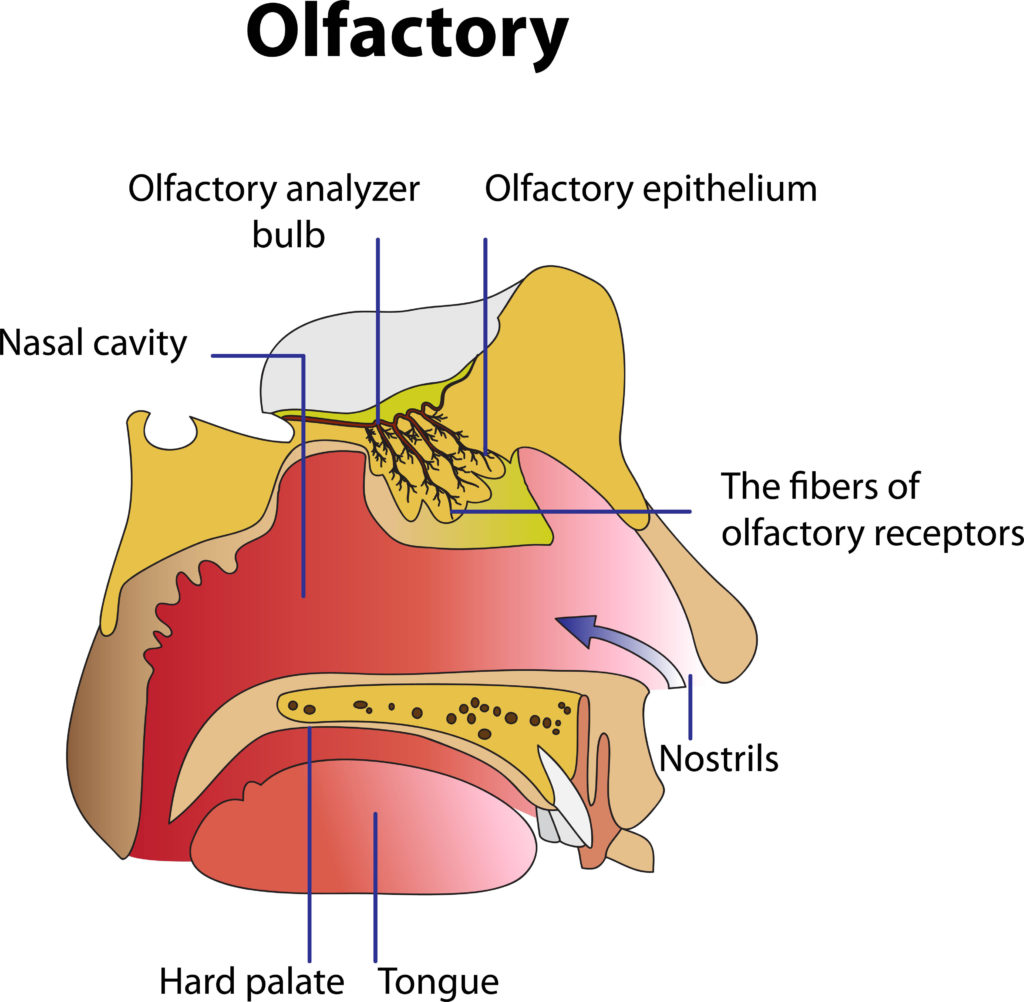Communication is a fundamental human need. We rely on it for protection, to share emotions, to empathize, and sometimes just for pleasure. But there is one communication method that may be ruling much of our interpersonal experience — and you probably don’t think of it as communication at all.
We communicate in a multitude of ways, including manipulating the tone of our voice, body language, facial expression, eye contact, gesturing, and even something as subtle as chemosignals — as in our smell!
That’s right smell.
If your mind immediately rushed to your four-legged friend and the way he or she sniffs to decide if they’re going to engage with another animal, you’re right! Our dogs often sniff far in the distance and use the information they get by smelling to make all sorts of decisions. This process is thanks to wonders of pheromones — and it works much the same in us humans.
While the olfactory part of our brain is slightly less developed then our visual cortex, our sense of smell is actually our oldest sensory system for communication.
And, while our sense of smell may be slightly less honed compared to our furry companions, the olfactory part of our brain has a direct line to the amygdala and orbitofrontal cortex. In other words, our sense of smell has a much more intimate relationship with the limbic system and hypothalamus, creating a much higher level of intimacy between our emotions, memory, and smells.

Think of how smells vividly, and even palpably, bring back memories and feelings. The smell of your grandma’s apple pie, the smell of grass being cut, the smell of sickness, the smell of a fire — they are almost guaranteed to create some kind of an emotional response.
And aside from emotions, smell impacts taste, appetite, and hunger cues because it also impacts us hormonally. Maybe we’re more primal than we thought?
How Does The Nose Know?
So you might be wondering, how does smell actually work? Do we all process smell the same way?
It turns out that most adults actually have a powerful ability to detect smells. In fact, most adults can distinguish between 1 trillion smells with their 40 million olfactory receptor neurons. However, some adult humans have what’s called anosmia, which is the inability to smell at all. That must stink, right?
For those who have the luxury of experiencing thousands of aromas, we begin by inhaling through our nose, where the air is filtered by little hairs called cilia. And before that air descends into your lungs, it hits a teensy mucus-covered patch at the back of your nose called the olfactory epithelium. Binding to the neurons, they send messages via the olfactory tract to various parts of your brain, including the amygdala, neocortex, and others.
This process is notable because it is one of our most primitive abilities, and one of the first senses to be established, scent has a direct pathway to these parts of our brain. Our other senses make a pitstop, if you will, in the mid-cerebral hemisphere and then travel to other parts of the brain. This direct route is what makes scent more emotionally impactful — triggering memories, fight or flight response, and other physiological responses.
Pheromones Known As Chemosignals
Out of those 1 trillion scents, our brain regularly processes, the smells we emit, experience, and interpret are understood as pheromones. Pheromones are a lot more dynamic than the media portrays — you know, simply attracting you to your one true love. They are, at their core, simple chemicals produced by every animal that impact the behavior or physical response of another animal.
Chemosignals are a unique form of pheromones that humans uniquely produce. This human version of pheromone, which has no detectable odor, helps us to relay important information to others.
For example, alarm pheromones are released when we encounter a threat. When you’re scared, your heart rate increases, your pupils dilate, and tiny beads of sweat form under your armpits. This fear response serves more than just to protect you. It also protects those around you because those tiny beads of sweat release chemicals, or chemo-signals that signal threat.

In fact, in a study funded by the US Defence Advanced Research Projects Agency – the Pentagon’s military research wing, Dr Lilianne Mujica-Parodi of Stony Brook University revealed some fascinating information.
During the study, Mujica-Parodi collected samples of sweat after the cohort experienced skydiving for the first time and then separately collected sweat, later on, from the same cohort while they were running on the treadmill. They had a separate group of volunteers smell each of the sweat samples. When they smelled the sweat from the treadmill group, there was no remarkable physiological change on a brain level.
But when they sniffed the sweat from the skydivers, there was clearly elevated activity in their amygdala (the fear center of their brain), implying they experienced the fear communication from the skydivers’ sweat.
In other words, the feelings you feel are detectable by others! So when your partner comes home and you can tell they are anxious, angry, or in a particular mood — you’re not crazy.
And, in 2012, Monique Smeets, a psychologist at Utrecht University, collected armpit sweat from a cohort who were made to watch scary movies. A separate cohort were exposed to the samples of the scary movie watchers, and not only did they exhibit facial markers of fear, but had increased blood pressure and heart rate, unlike samples of sweat collected under neutral conditions.
It makes sense. Because of the immediate communication between the olfactory epithelium and various parts of our brain, including our amygdala, it’s no wonder that when we detect a chemosignal that conveys fear, we experience it physiologically.
With such heightened levels of anxiety, fear, and other emotions all around us, it’s undeniable that those emotions are impacting us via these chemosignals. And because of our social nature as humans, we end up mimicking others’ behaviors and emotions thanks to what’s called Emotional Contagion.
So, the emotional impact of what’s going on around us is real. But is there anything we can do about it?
While there is no real cure or bubble we can put ourselves in, the simple act of building a vocabulary and awareness of the emotions you feel in real-time can help. Checking in with what may be causing those emotions and where they may be coming from can help you identify if you’re really feeling anxious about a particular task or situation, or if you’re simply experiencing the rub-off of a colleague or hangry partner.
A little more specifically, there are three actions you can take to be less emotionally impacted:
- If you are aware of the source of emotional contagion, making a conscious choice to spend less time with that thing, or person is an easy way to reduce the undesirable emotional conveyance. This is particularly helpful if the anxiety, fear, or guilt-inducing culprit is your phone (looking at you, Instagram, Twitter, and news channel) or a particular person.
- Try to positively contribute to the conversation. In many cases, we don’t necessarily have control over stopping our own emotions in their tracks. But we can potentially transition someone else’s emotions as they arrive. If you’re having a conversation with an anxious or angry colleague or friend, you’re relaxed, positive mood chemosignals may soothe them (although, no guarantees!).
- Be aware and honest. Sometimes people are just generally negative for no good reason. If you can’t avoid them entirely, let them know – hey, I don’t like how your negativity makes me feel. If you’re feeling super nerdy, and they are receptive, you can even tell them about chemosignals. After all, if there is an elevated morale amongst colleagues, productivity increases! Now that’s something that every boss wants for their team!
While this is just the beginning, and as always, will need more digging, more studies, and deeper understanding, an additional way to build relationship with our emotions is not just exciting, but yields plenty of potential when it comes to higher-level communication and performance. Tune in for yourself today, and explore what emotions you feel, express, and how they impact those around you!
Works Cited
“Anosmia (Lost Sense of Smell): Definition, Causes, Symptoms.” Cleveland Clinic, my.clevelandclinic.org/health/diseases/21859-anosmia-loss-of-sense-of-smell#:~:text=The%20term%20. Accessed 25 July 2022.
Araujo, Laura. “Light Phone: The New Way to Give Your Nervous System a Break, While Still Remaining Connected and Human.” Themapsinstitute.com, 24 Sept. 2021, themapsinstitute.com/light-phone/. Accessed 25 July 2022.
Boone, R. Thomas, and Ross Buck. Journal of Nonverbal Behavior, vol. 27, no. 3, 2003, pp. 163–182, 10.1023/a:1025341931128.
“Brandessence.” Www.brandessence.com.tr, www.brandessence.com.tr/en/koku_bilimi.html. Accessed 25 July 2022.
Bushdid, C, et al. “Humans Can Discriminate More than 1 Trillion Olfactory Stimuli.” Science (New York, N.Y.), vol. 343, no. 6177, 2014, pp. 1370–2, www.ncbi.nlm.nih.gov/pubmed/24653035?dopt=Abstract&holding=npg, 10.1126/science.1249168.
Calvi, Elisa, et al. “The Scent of Emotions: A Systematic Review of Human Intra‐ and Interspecific Chemical Communication of Emotions.” Brain and Behavior, vol. 10, no. 5, 25 Mar. 2020, 10.1002/brb3.1585. Accessed 8 Dec. 2021.
de Groot, Jasper H. B., et al. “Chemosignals Communicate Human Emotions.” Psychological Science, vol. 23, no. 11, 27 Sept. 2012, pp. 1417–1424, 10.1177/0956797612445317.
Herz, Rachel. “The Role of Odor-Evoked Memory in Psychological and Physiological Health.” Brain Sciences, vol. 6, no. 3, 19 July 2016, p. 22, www.ncbi.nlm.nih.gov/pmc/articles/PMC5039451/, 10.3390/brainsci6030022.
Hughes, Susan M., et al. “The Perception and Parameters of Intentional Voice Manipulation.” Journal of Nonverbal Behavior, vol. 38, no. 1, 1 Oct. 2013, pp. 107–127, 10.1007/s10919-013-0163-z. Accessed 5 Nov. 2021.
“Humans Can Identify More than 1 Trillion Smells.” National Institutes of Health (NIH), 12 May 2015, www.nih.gov/news-events/nih-research-matters/humans-can-identify-more-1-trillion-smells.
Kevetter, Golda A., and Sarah S. Winans. “Connections of the Corticomedial Amygdala in the Golden Hamster. II. Efferents of the ?Olfactory Amygdala?” The Journal of Comparative Neurology, vol. 197, no. 1, 20 Mar. 1981, pp. 99–111, 10.1002/cne.901970108. Accessed 8 June 2019.
Mujica-Parodi, Lilianne R., et al. “Chemosensory Cues to Conspecific Emotional Stress Activate Amygdala in Humans.” PloS One, vol. 4, no. 7, 29 July 2009, p. e6415, www.ncbi.nlm.nih.gov/pubmed/19641623, 10.1371/journal.pone.0006415. Accessed 30 Apr. 2020.
Petrulis, Aras. “Chemosignals, Hormones and Mammalian Reproduction.” Hormones and Behavior, vol. 63, no. 5, May 2013, pp. 723–741, 10.1016/j.yhbeh.2013.03.011. Accessed 29 Mar. 2021.
Purves, Dale, et al. “The Olfactory Epithelium and Olfactory Receptor Neurons.” Neuroscience. 2nd Edition, 2001, www.ncbi.nlm.nih.gov/books/NBK10896/.
Reynolds, Lila. “Your Sense of Smell May Be the Key to a Balanced Diet: We Are Less Likely to Perceive Smells of Food That Relate to a Recent Meal, Helping Us Make Choices about What to Eat Next.” ScienceDaily, 2021, www.sciencedaily.com/releases/2021/08/210826170130.htm.
Silva, Karine, and Liliana de Sousa. ““ Canis Empathicus ”? A Proposal on Dogs’ Capacity to Empathize with Humans.” Biology Letters, vol. 7, no. 4, 16 Feb. 2011, pp. 489–492, 10.1098/rsbl.2011.0083.
Siniscalchi, Marcello, et al. “The Dog Nose “KNOWS” Fear: Asymmetric Nostril Use during Sniffing at Canine and Human Emotional Stimuli.” Behavioural Brain Research, vol. 304, May 2016, pp. 34–41, 10.1016/j.bbr.2016.02.011. Accessed 29 Apr. 2019.
“Smell You Later! Chemosignals Communicate Human Emotions.” ScienceDaily, www.sciencedaily.com/releases/2012/11/121105140407.htm.
Walsh, Colleen. “How Scent, Emotion, and Memory Are Intertwined — and Exploited.” Harvard Gazette, 27 Feb. 2020, news.harvard.edu/gazette/story/2020/02/how-scent-emotion-and-memory-are-intertwined-and-exploited/.
Wang, Zhengwei, et al. “Bees Eavesdrop upon Informative and Persistent Signal Compounds in Alarm Pheromones.” Scientific Reports, vol. 6, no. 1, May 2016, 10.1038/srep25693. Accessed 3 Mar. 2020.
Willis, Janine, and Alexander Todorov. “First Impressions: Making up Your Mind after a 100-Ms Exposure to a Face.” Psychological Science, vol. 17, no. 7, July 2006, pp. 592–598, 10.1111/j.1467-9280.2006.01750.x.
Zeng, Runxi, and Di Zhu. “A Model and Simulation of the Emotional Contagion of Netizens in the Process of Rumor Refutation.” Scientific Reports, vol. 9, no. 1, 2 Oct. 2019, 10.1038/s41598-019-50770-4. Accessed 20 May 2022.
